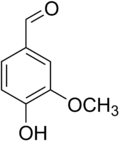香草醛
此條目需要擴充。 (2008年4月13日) |
| 香草醛 | |
|---|---|

| |

| |
| IUPAC名 4-Hydroxy-3-methoxybenzaldehyde | |
| 別名 | 香蘭素 Vanillic aldehyde Methyl vanillin |
| 識別 | |
| CAS號 | 121-33-5 |
| PubChem | 1183 |
| ChemSpider | 13860434 |
| SMILES |
|
| InChI |
|
| InChIKey | MWOOGOJBHIARFG-UHFFFAOYAS |
| Beilstein | 472792 |
| Gmelin | 3596 |
| 3DMet | B00167 |
| EINECS | 204-465-2 |
| ChEBI | 18346 |
| RTECS | YW5775000 |
| KEGG | D00091 |
| MeSH | vanillin |
| IUPHAR配體 | 6412 |
| 性質 | |
| 化學式 | C8H8O3 |
| 摩爾質量 | 152.15 g·mol⁻¹ |
| 外觀 | 白色至微黃色固體 (針狀晶體) |
| 氣味 | 具有香草香氣,呈甜味、奶香、令人愉悅的氣味 |
| 密度 | 1.056 [1]g·cm-3 |
| 熔點 | 80—81 °C(353—354 K)[2] |
| 沸點 | 285°C (558 K) [1] |
| 溶解性(水) | 1 g/100 ml (25°C) |
| log P | 1.208 |
| 黏度 | ? cP(?°C) |
| 危險性 | |
| 警示術語 | R:R22 |
| 安全術語 | S:S24/25 |
| MSDS | 英文MSDS |
| GHS提示詞 | WARNING |
| H-術語 | H302, H317, H319 |
| P-術語 | P280, P305+351+338 |
| 主要危害 | 可能對皮膚、眼部和呼吸系統造成刺激 |
| NFPA 704 | |
| 閃點 | 147°C |
| 相關物質 | |
| 相關化學品 | 丁香酚、茴香醛、苯酚 |
| 若非註明,所有數據均出自標準狀態(25 ℃,100 kPa)下。 | |
香草醛(英語:Vanillin,通稱香蘭素),是一種白色至微黃色針狀結晶的酚醛,化學式為C8H8O3,官能團包含醛基、羥基和醚鍵。香草醛是香莢蘭豆的天然提取物主要成分,是重要的食用香料之一。現今人工合成的香草醛被廣泛應用於食品、飲料和醫藥領域的調香。
乙基香蘭素的香氣強度和留香時間都強於香蘭素,是一種重要的人工合成香料。最初香草醛由天然原料丁香油中的丁香油酚出發合成,而今更經濟的選擇是製漿產業中的木質素法,或是以石油化工前體的愈創木酚和乙醛酸為原料的路線。據稱,木質素法的合成香草素有更豐富的風味層次,而產生差異的原因是香草乙酮。[3][註 1]
歷史
[編輯]儘管普遍認為香草是在中美洲被馴化的,隨後在16世紀傳播到舊大陸,但在2019年發表的一篇論文指出,在以色列一座古墓中的罐子裡發現了香蘭素殘留物,其年代可追溯到公元前兩千年。這表明自中期青銅時代以來,迦南可能種植了一種尚未確認、舊大陸特有的香草物種。[4][5]在耶路撒冷的酒罐中也發現了香蘭素的痕跡,這些酒罐被認為是猶大族權貴在耶路撒冷之圍前的公元前 586 年所使用的。[5]
香莢蘭豆是中美洲原住民發現和種植的飲料調味品(阿茲特克人稱為tlilxochitl),其中最著名的是現代墨西哥韋拉克魯斯州的托托納克人。最晚自 15 世紀初開始,阿茲特克人就在名為 "xocohotl "的飲料中使用香草作為巧克力的調料。[6]
1858 年泰奧多爾·尼古拉斯·高布利首次分離出相對純淨的香蘭素,他將香草提取液蒸乾,然後重結晶得到固體。[7]1874 年,德國科學家費迪南德·悌曼和威廉·哈曼推斷出了它的化學結構,同時發現了從松柏苷(一種從松柏樹皮中發現的異丁香油酚的葡萄糖苷)合成香蘭素的路線。[8]悌曼和哈曼成立了哈曼·雷默公司(現為德之馨的一部分),並在霍爾茨明登利用他們的工藝(即Reimer–Tiemann反應)開始了香蘭素的首次工業生產。1876 年,卡爾·雷默首次用愈創木酚(1)合成了香蘭素(2)。[9]

到 19 世紀末,從丁香油中的丁香油酚衍生的半合成香蘭素已經可以在市場上買到。[10][註 2]合成香蘭素在1930年代變得更普及,彼時丁香油法香蘭素被從造紙業製備木漿的亞硫酸鹽製漿法所產生的廢液中的木質素法合成香蘭素所取代。在1981 年,索羅爾德的一家紙漿造紙企業供應了全球 60% 的合成香蘭素市場。[11]然而,木漿工業隨後的發展使木質素廢料作為合成香蘭素原料的競爭力下降。如今,全球生產的香蘭素中只有約 15% 是用木質素廢料製成的[12] ,而約 85% 是通過兩步法從石油化工前體愈創木酚和乙醛酸合成的。[13][14]
分布
[編輯]
香蘭素是香草中最主要的風味來源,風乾的香草莢中含有約2% 的香蘭素。在品質優良的干豆莢上,相對純淨的香蘭素可能會以白色粉末或「霜」的形式掛在豆莢表面。原產於巴拉圭和巴西南部的一種筒葉蘭香釵蘭[15]和中國油松中也有香蘭素。
在低濃度下,香蘭素可為橄欖油 [16]、黃油 [17] 、樹莓 [18] 和荔枝[19]等許多食品增添香氣。橡木桶陳釀會賦予一些葡萄酒、醋 [20]和烈酒[21]香蘭素的香氣。
在其他食品中,加熱可能會由其他化合物產生香蘭素,並為其提供香草的風味和香氣,比如咖啡[22][16]、楓糖[23]和全谷產品(包括墨西哥薄餅 [24]和燕麥片[25])。
用途
[編輯]可用於食品生產中,具有配製食用香精的作用,同時也可用於醫藥、日化、電鍍、飼料等其他方面。
貯存
[編輯]在陰涼、乾燥、避光和的通風室內處貯存,需防止日曬雨淋。
製作方法
[編輯]把香草莢剖開取出香草籽,再和剪成小段的香草莢枝幹一起浸泡在40度以上的酒中(一般可以選取白朗姆酒/伏特加等),浸泡3個月左右。
參考文獻
[編輯]- ^ 1.0 1.1 Haynes, William M. (編). CRC Handbook of Chemistry and Physics 97th. CRC Press. 2016: 3.310. ISBN 978-1-4987-5429-3.
- ^ Rosenmund, K. W.; Weiler, G. Catalytic reduction of acid chlorides VI. Preparation of unsaturated aldehydes. Berichte der Deutschen Chemischen Gesellschaft [Abteilung] B: Abhandlungen, 1923. 56B. 1481-1487. ISSN: 0365-9488.
- ^ Esposito, Lawrence J.; K. Formanek; G. Kientz; F. Mauger; V. Maureaux; G. Robert; F. Truchet. Vanillin. Kirk-Othmer Encyclopedia of Chemical Technology, 4th edition 24. New York: John Wiley & Sons: 812–825. 1997. ISBN 978-0-471-52693-3.
- ^ Linares, V.; Adams, M. J.; Cradic, M. S.; Finkelstein, I.; Lipschits, O.; Martin, M. A. S.; Neumann, R.; Stockhammer, P. W.; Gadot, Y. First evidence for vanillin in the old world: Its use as mortuary offering in Middle Bronze Canaan. Journal of Archaeological Science: Reports. June 2019, 25: 77–84 [2024-06-17]. Bibcode:2019JArSR..25...77L. S2CID 181608839. doi:10.1016/j.jasrep.2019.03.034. (原始內容存檔於2023-07-05).
- ^ 5.0 5.1 Amir, A.; Finkelstein, I.; Shalev, Y.; Uziel, J.; Chalaf, O.; Freud, L.; Neumann, R.; Gadot, Y. Amir A, Finkelstein I, Shalev Y, Uziel J, Chalaf O, Freud L, et al. (2022) Residue analysis evidence for wine enriched with vanilla consumed in Jerusalem on the eve of the Babylonian destruction in 586 BCE. PLoS ONE 17(3). PLOS ONE. 2022, 17 (3): e0266085. PMC 8963535
 . PMID 35349581. doi:10.1371/journal.pone.0266085
. PMID 35349581. doi:10.1371/journal.pone.0266085  .
.
- ^ MexicanVanilla.com. Mexican Vanilla - A History. MexicanVanilla.com. [2022-06-14]. (原始內容存檔於2024-09-10) (英語).
- ^ Gobley, M. Recherches sur le principe odorant de la vanille. Journal de Pharmacie et de Chimie. 1858, 34: 401–405.
- ^ Tiemann, Ferd.; Wilh. Haarmann. Ueber das Coniferin und seine Umwandlung in das aromatische Princip der Vanille. Berichte der Deutschen Chemischen Gesellschaft. 1874, 7 (1): 608–623 [2024-06-17]. doi:10.1002/cber.187400701193. (原始內容存檔於2023-07-05).
- ^ Reimer, Karl Ludwig. Ueber eine neue Bildungsweise aromatischer Aldehyde. Berichte der Deutschen Chemischen Gesellschaft. 1876, 9 (1): 423–424 [2024-06-17]. doi:10.1002/cber.187600901134. (原始內容存檔於2023-07-09).
- ^ Hocking, Martin B. Vanillin: Synthetic Flavoring from Spent Sulfite Liquor (PDF). Journal of Chemical Education. September 1997, 74 (9): 1055–1059 [2006-09-09]. Bibcode:1997JChEd..74.1055H. doi:10.1021/ed074p1055. (原始內容存檔於2008-12-02).
- ^ Hocking 1997.
- ^ Fache, Maxence; Boutevin, Bernard; Caillol, Sylvain. Vanillin Production from Lignin and Its Use as a Renewable Chemical. ACS Sustain. Chem. Eng. 2015, 4 (1): 35–46. doi:10.1021/acssuschemeng.5b01344.
- ^ Esposito 1997.
- ^ Kamlet, Jonas & Mathieson, Olin. Manufacture of vanillin and its homologues U.S. Patent 2,640,083 (PDF). U.S. Patent Office. 1953 [2024-06-17]. (原始內容存檔 (PDF)於2021-04-30).
- ^ Leptotes bicolor. Flora Library. [2011-08-21]. (原始內容存檔於2021-04-30).
- ^ 16.0 16.1 Brenes, Manuel; Aranzazu García; Pedro García; José J. Rios; Antonio Garrido. Phenolic Compounds in Spanish Olive Oils. Journal of Agricultural and Food Chemistry. 1999, 47 (9): 3535–3540. PMID 10552681. doi:10.1021/jf990009o.
- ^ Vreuls, René J. J.; van der Heijden, Arnold; Brinkman, Udo A. Th.; Adahchour, Mohamed. Trace-level determination of polar flavour compounds in butter by solid-phase extraction and gas chromatography–mass spectrometry. Journal of Chromatography A. 1999, 844 (1–2): 295–305. PMID 10399332. doi:10.1016/S0021-9673(99)00351-9.
- ^ Roberts, Deborah D.; Terry E. Acree. Effects of Heating and Cream Addition on Fresh Raspberry Aroma Using a Retronasal Aroma Simulator and Gas Chromatography Olfactometry. Journal of Agricultural and Food Chemistry. 1996, 44 (12): 3919–3925. doi:10.1021/jf950701t.
- ^ Ong, Peter K. C.; Terry E. Acree. Gas Chromatography/Olfactory Analysis of Lychee (Litchi chinesis Sonn.). Journal of Agricultural and Food Chemistry. 1998, 46 (6): 2282–2286. doi:10.1021/jf9801318.
- ^ Carrero Gálvez, Miguel. Analysis of polyphenolic compounds of different vinegar samples. Zeitschrift für Lebensmittel-Untersuchung und -Forschung. 1994, 199: 29–31. S2CID 91784893. doi:10.1007/BF01192948..
- ^ Viriot, Carole; Augustin Scalbert; Catherine Lapierre; Michel Moutounet. Ellagitannins and lignins in aging of spirits in oak barrels. Journal of Agricultural and Food Chemistry. 1993, 41 (11): 1872–1879. doi:10.1021/jf00035a013.
- ^ Semmelroch, P.; Laskawy, G.; Blank, I.; Grosch, W. Determination of potent odourants in roasted coffee by stable isotope dilution assays. Flavour and Fragrance Journal. 1995, 10: 1–7. doi:10.1002/ffj.2730100102.
- ^ Kermasha, S.; M. Goetghebeur; J. Dumont. Determination of Phenolic Compound Profiles in Maple Products by High-Performance Liquid Chromatography. Journal of Agricultural and Food Chemistry. 1995, 43 (3): 708–716. doi:10.1021/jf00051a028.
- ^ Buttery, Ron G.; Louisa C. Ling. Volatile Flavor Components of Corn Tortillas and Related Products. Journal of Agricultural and Food Chemistry. 1995, 43 (7): 1878–1882. doi:10.1021/jf00055a023.
- ^ Guth, Helmut; Werner Grosch. Odorants of extrusion products of oat meal: Changes during storage. Zeitschrift für Lebensmittel-Untersuchung und -Forschung A. 1995, 196 (1): 22–28. S2CID 82716730. doi:10.1007/BF01192979.
注釋
[編輯]- ^ 根據 Esposito 1997,盲測小組無法區分木質素和愈創木酚來源合成的香蘭素,但可以分辨二者的氣味。若向愈創木酚來源的香蘭素中摻入香草乙酮,則無法區分二者的香氣差異。
- ^ 根據Hocking 1997,合成香蘭素於 1874 年開始商業銷售。同年,現代香精香料製造商德之馨公司的前身之一哈曼•雷默公司發表悌曼和哈曼的原始合成方法。不過,據Esposito 1997稱,合成香蘭素最早出現於 1894年,當時羅納-普朗克公司開始涉足香蘭素業務。

